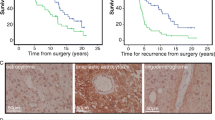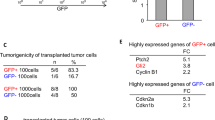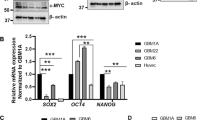Abstract
Glioblastoma (GBM) is an aggressive malignant brain tumor that still lacks effective therapy. Glioblastoma stem cells (GBM-SCs) were identified to contribute to aggressive phenotypes and poor clinical outcomes for GBM. Netrin-1, an axon guidance molecule, has been found in several tumors in adults. However, the role of Netrin-1 in GBM-SCs remains largely unknown. In this study, CD133-positive U251 GBM cells were used as a putative GBM-SC population to identify the functions of Netrin-1. Using lentiviral transduction, Netrin-1 miR RNAi vectors were transduced into CD133-positive U251 cells. We demonstrated that cell proliferation and survival were decreased following targeted deletion of Netrin-1. Cell invasion was dramatically diminished in Netrin-1 knockdown GBM-SCs. Moreover, Netrin-1 knockdown GBM-SCs exhibited less proangiogenic activity. In conclusion, Netrin-1 may represent a therapeutic target in glioblastoma.





Similar content being viewed by others
References
Furnari FB, Fenton T, Bachoo RM, et al. Malignant astrocytic glioma: genetics, biology, and paths to treatment. Genes Dev. 2007;21:2683–710.
Stupp R, Hegi ME, Mason WP, et al. Effects of radiotherapy with concomitant and adjuvant temozolomide versus radiotherapy alone on survival in glioblastoma in a randomised phase iii study: 5-year analysis of the eortc-ncic trial. Lancet Oncol. 2009;10:459–66.
Stupp R, Mason WP, van den Bent MJ, et al. Radiotherapy plus concomitant and adjuvant temozolomide for glioblastoma. N Engl J Med. 2005;352:987–96.
Ostrom QT, Gittleman H, Liao P, et al. Cbtrus statistical report: primary brain and central nervous system tumors diagnosed in the United States in 2007-2011. Neuro Oncol. 2014;16(Suppl 4):iv1–63.
Urbanska K, Sokolowska J, Szmidt M, Sysa P. Glioblastoma multiforme—an overview. Contemp Oncol (Pozn). 2014;18:307–12.
Bello MJ, Alonso ME, Aminoso C, et al. Hypermethylation of the DNA repair gene mgmt: association with tp53 g:C to a:T transitions in a series of 469 nervous system tumors. Mutat Res. 2004;554:23–32.
Kamiryo T, Tada K, Shiraishi S, et al. Correlation between promoter hypermethylation of the o6-methylguanine-deoxyribonucleic acid methyltransferase gene and prognosis in patients with high-grade astrocytic tumors treated with surgery, radiotherapy, and 1-(4-amino-2-methyl-5-pyrimidinyl)methyl-3-(2-chloroethyl)-3-nitrosourea-based chemotherapy. Neurosurgery. 2004;54:349–57 .discussion 57
Al-Hajj M, Wicha MS, Benito-Hernandez A, et al. Prospective identification of tumorigenic breast cancer cells. Proc Natl Acad Sci U S A. 2003;100:3983–8.
Collins AT, Berry PA, Hyde C, et al. Prospective identification of tumorigenic prostate cancer stem cells. Cancer Res. 2005;65:10946–51.
Li C, Heidt DG, Dalerba P, et al. Identification of pancreatic cancer stem cells. Cancer Res. 2007;67:1030–7.
Ignatova TN, Kukekov VG, Laywell ED, et al. Human cortical glial tumors contain neural stem-like cells expressing astroglial and neuronal markers in vitro. Glia. 2002;39:193–206.
Singh SK, Clarke ID, Terasaki M, et al. Identification of a cancer stem cell in human brain tumors. Cancer Res. 2003;63:5821–8.
Reya T, Morrison SJ, Clarke MF, Weissman IL. Stem cells, cancer, and cancer stem cells. Nature. 2001;414:105–11.
Patel AP, Tirosh I, Trombetta JJ, et al. Single-cell rna-seq highlights intratumoral heterogeneity in primary glioblastoma. Science. 2014;344:1396–401.
Meyer M, Reimand J, Lan X, et al. Single cell-derived clonal analysis of human glioblastoma links functional and genomic heterogeneity. Proc Natl Acad Sci U S A. 2015;112:851–6.
Johannessen TC, Wang J, Skaftnesmo KO, et al. Highly infiltrative brain tumours show reduced chemosensitivity associated with a stem cell-like phenotype. Neuropathol Appl Neurobiol. 2009;35:380–93.
Liu G, Yuan X, Zeng Z, et al. Analysis of gene expression and chemoresistance of cd133+ cancer stem cells in glioblastoma. Mol Cancer. 2006;5:67.
Chen R, Nishimura MC, Bumbaca SM, et al. A hierarchy of self-renewing tumor-initiating cell types in glioblastoma. Cancer Cell. 2010;17:362–75.
Singh SK, Hawkins C, Clarke ID, et al. Identification of human brain tumour initiating cells. Nature. 2004;432:396–401.
Yuan X, Curtin J, Xiong Y, et al. Isolation of cancer stem cells from adult glioblastoma multiforme. Oncogene. 2004;23:9392–400.
Graef IA, Wang F, Charron F, et al. Neurotrophins and netrins require calcineurin/nfat signaling to stimulate outgrowth of embryonic axons. Cell. 2003;113:657–70.
Ming GL, Song HJ, Berninger B, et al. Camp-dependent growth cone guidance by netrin-1. Neuron. 1997;19:1225–35.
Serafini T, Kennedy TE, Galko MJ, et al. The netrins define a family of axon outgrowth-promoting proteins homologous to C. elegans unc-6. Cell. 1994;78:409–24.
Delloye-Bourgeois C, Brambilla E, Coissieux MM, et al. Interference with netrin-1 and tumor cell death in non-small cell lung cancer. J Natl Cancer Inst. 2009;101:237–47.
Dumartin L, Quemener C, Laklai H, et al. Netrin-1 mediates early events in pancreatic adenocarcinoma progression, acting on tumor and endothelial cells. Gastroenterology. 2010;138:1595–606 .606 e1-8
Paradisi A, Maisse C, Coissieux MM, et al. Netrin-1 up-regulation in inflammatory bowel diseases is required for colorectal cancer progression. Proc Natl Acad Sci U S A. 2009;106:17146–51.
Qi Q, Li DY, Luo HR, et al. Netrin-1 exerts oncogenic activities through enhancing yes-associated protein stability. Proc Natl Acad Sci U S A. 2015;112:7255–60.
Akino T, Han X, Nakayama H, et al. Netrin-1 promotes medulloblastoma cell invasiveness and angiogenesis, and demonstrates elevated expression in tumor tissue and urine of patients with pediatric medulloblastoma. Cancer Res. 2014;74:3716–26.
Mazelin L, Bernet A, Bonod-Bidaud C, et al. Netrin-1 controls colorectal tumorigenesis by regulating apoptosis. Nature. 2004;431:80–4.
Delloye-Bourgeois C, Fitamant J, Paradisi A, et al. Netrin-1 acts as a survival factor for aggressive neuroblastoma. J Exp Med. 2009;206:833–47.
Llambi F, Causeret F, Bloch-Gallego E, Mehlen P. Netrin-1 acts as a survival factor via its receptors unc5h and dcc. EMBO J. 2001;20:2715–22.
Shimizu A, Nakayama H, Wang P, et al. Netrin-1 promotes glioblastoma cell invasiveness and angiogenesis by multiple pathways including activation of rhoa, cathepsin b, and camp-response element-binding protein. J Biol Chem. 2013;288:2210–22.
Ylivinkka I, Hu Y, Chen P, et al. Netrin-1-induced activation of notch signaling mediates glioblastoma cell invasion. J Cell Sci. 2013;126:2459–69.
Fitamant J, Guenebeaud C, Coissieux MM, et al. Netrin-1 expression confers a selective advantage for tumor cell survival in metastatic breast cancer. Proc Natl Acad Sci U S A. 2008;105:4850–5.
Galli R, Binda E, Orfanelli U, et al. Isolation and characterization of tumorigenic, stem-like neural precursors from human glioblastoma. Cancer Res. 2004;64:7011–21.
Goffart N, Kroonen J, Rogister B. Glioblastoma-initiating cells: relationship with neural stem cells and the micro-environment. Cancers (Basel). 2013;5:1049–71.
Uchida N, Buck DW, He D, et al. Direct isolation of human central nervous system stem cells. Proc Natl Acad Sci U S A. 2000;97:14720–5.
Calabrese C, Poppleton H, Kocak M, et al. A perivascular niche for brain tumor stem cells. Cancer Cell. 2007;11:69–82.
Wang W, Reeves WB, Pays L, et al. Netrin-1 overexpression protects kidney from ischemia reperfusion injury by suppressing apoptosis. Am J Pathol. 2009;175:1010–8.
Bao S, Wu Q, Sathornsumetee S, et al. Stem cell-like glioma cells promote tumor angiogenesis through vascular endothelial growth factor. Cancer Res. 2006;66:7843–8.
Tadagavadi RK, Wang W, Ramesh G. Netrin-1 regulates th1/th2/th17 cytokine production and inflammation through unc5b receptor and protects kidney against ischemia-reperfusion injury. J Immunol. 2010;185:3750–8.
Tsuchiya A, Hayashi T, Deguchi K, et al. Expression of netrin-1 and its receptors dcc and neogenin in rat brain after ischemia. Brain Res. 2007;1159:1–7.
Mehlen P, Guenebeaud C. Netrin-1 and its dependence receptors as original targets for cancer therapy. Curr Opin Oncol. 2010;22:46–54.
Forcet C, Stein E, Pays L, et al. Netrin-1-mediated axon outgrowth requires deleted in colorectal cancer-dependent mapk activation. Nature. 2002;417:443–7.
Shekarabi M, Moore SW, Tritsch NX, et al. Deleted in colorectal cancer binding netrin-1 mediates cell substrate adhesion and recruits cdc42, rac1, pak1, and n-wasp into an intracellular signaling complex that promotes growth cone expansion. J Neurosci. 2005;25:3132–41.
Liu G, Beggs H, Jurgensen C, et al. Netrin requires focal adhesion kinase and src family kinases for axon outgrowth and attraction. Nat Neurosci. 2004;7:1222–32.
Rajasekharan S, Bin JM, Antel JP, Kennedy TEA. Central role for rhoa during oligodendroglial maturation in the switch from netrin-1-mediated chemorepulsion to process elaboration. J Neurochem. 2010;113:1589–97.
Lepekhin EA, Eliasson C, Berthold CH, et al. Intermediate filaments regulate astrocyte motility. J Neurochem. 2001;79:617–25.
Hagemann C, Anacker J, Ernestus RI, Vince GHA. Complete compilation of matrix metalloproteinase expression in human malignant gliomas. World J Clin Oncol. 2012;3:67–79.
Fanjul-Fernandez M, Folgueras AR, Cabrera S, Lopez-Otin C. Matrix metalloproteinases: evolution, gene regulation and functional analysis in mouse models. Biochim Biophys Acta. 2010;1803:3–19.
McCready J, Broaddus WC, Sykes V, Fillmore HL. Association of a single nucleotide polymorphism in the matrix metalloproteinase-1 promoter with glioblastoma. Int J Cancer. 2005;117:781–5.
Komatsu K, Nakanishi Y, Nemoto N, et al. Expression and quantitative analysis of matrix metalloproteinase-2 and −9 in human gliomas. Brain Tumor Pathol. 2004;21:105–12.
Wang M, Wang T, Liu S, et al. The expression of matrix metalloproteinase-2 and −9 in human gliomas of different pathological grades. Brain Tumor Pathol. 2003;20:65–72.
Rao JS. Molecular mechanisms of glioma invasiveness: the role of proteases. Nat Rev Cancer. 2003;3:489–501.
Lakka SS, Gondi CS, Yanamandra N, et al. Inhibition of cathepsin b and mmp-9 gene expression in glioblastoma cell line via rna interference reduces tumor cell invasion, tumor growth and angiogenesis. Oncogene. 2004;23:4681–9.
Eeckhout Y, Vaes G. Further studies on the activation of procollagenase, the latent precursor of bone collagenase. Effects of lysosomal cathepsin b, plasmin and kallikrein, and spontaneous activation. Biochem J. 1977;166:21–31.
Tu T, Zhang C, Yan H, et al. Cd146 acts as a novel receptor for netrin-1 in promoting angiogenesis and vascular development. Cell Res. 2015;25:275–87.
Acknowledgments
The authors thank to the Faculty of Medical Technology, Mahidol University for facility support, Siriraj Core Research Facility (SiCRF) for assistance with flow cytometry and members of Siriraj Center of Excellence for Stem Cell Research (SiSCR) for their supports and helpful discussions.
Author information
Authors and Affiliations
Corresponding authors
Ethics declarations
Funding
This research project was funded by grants from Mahidol University, Thailand Research Fund (Grant no. RTA 488-0007), the Commission on Higher Education (Grant no. CHE-RES-RG-49). S.I. is a Senior Research Scholar of Thailand Research Fund. T.S. was supported by the Thailand Research Funds through the Royal Golden Jubilee PhD Program (PhD/0199/2550). S.S. is partially supported by grants from the National Nanotechnology Center (NANOTEC), NSTDA, Ministry of Science and Technology through its program of Center of Excellence Network and Faculty of Medicine Siriraj Hospital, Mahidol University.
Conflicts of interest
None
Electronic supplementary material
ESM 1
(DOCX 28 kb)
Supplementary Table 1
(DOCX 18 kb)
Supplementary Table 2
(DOCX 17 kb)
Supplementary Table 3
(DOCX 17 kb)
Supplementary Fig. 1
(DOCX 281 kb)
Supplementary Fig. 2
(DOCX 2055 kb)
Supplementary Fig. 3
(DOCX 777 kb)
Supplementary Fig. 4
(DOCX 1338 kb)
Supplementary Fig. 5
(DOCX 39 kb)
Supplementary Fig. 6
(DOCX 392 kb)
Supplementary Fig. 7
(DOCX 640 kb)
Rights and permissions
About this article
Cite this article
Sanvoranart, T., Supokawej, A., Kheolamai, P. et al. Targeting Netrin-1 in glioblastoma stem-like cells inhibits growth, invasion, and angiogenesis. Tumor Biol. 37, 14949–14960 (2016). https://doi.org/10.1007/s13277-016-5314-5
Received:
Accepted:
Published:
Issue Date:
DOI: https://doi.org/10.1007/s13277-016-5314-5




